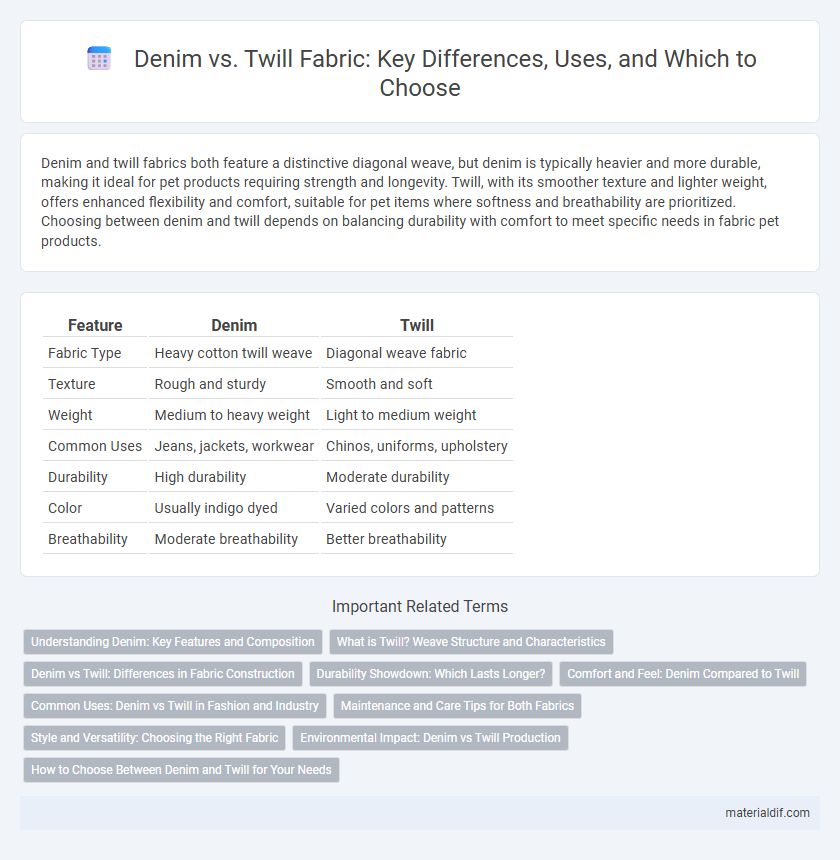Denim and twill fabrics both feature a distinctive diagonal weave, but denim is typically heavier and more durable, making it ideal for pet products requiring strength and longevity. Twill, with its smoother texture and lighter weight, offers enhanced flexibility and comfort, suitable for pet items where softness and breathability are prioritized. Choosing between denim and twill depends on balancing durability with comfort to meet specific needs in fabric pet products.
Table of Comparison
| Feature | Denim | Twill |
|---|---|---|
| Fabric Type | Heavy cotton twill weave | Diagonal weave fabric |
| Texture | Rough and sturdy | Smooth and soft |
| Weight | Medium to heavy weight | Light to medium weight |
| Common Uses | Jeans, jackets, workwear | Chinos, uniforms, upholstery |
| Durability | High durability | Moderate durability |
| Color | Usually indigo dyed | Varied colors and patterns |
| Breathability | Moderate breathability | Better breathability |
Understanding Denim: Key Features and Composition
Denim is a durable cotton twill fabric characterized by its diagonal ribbing created through the weaving process, typically dyed with indigo to produce its iconic blue color. Unlike standard twill, denim uses a warp-faced weaving technique where the weft thread passes under two or more warp threads, enhancing strength and texture. Its composition commonly involves 100% cotton or a cotton-polyester blend, providing durability and comfort ideal for jeans and workwear.
What is Twill? Weave Structure and Characteristics
Twill is a distinctive fabric weave structure characterized by diagonal parallel ribs formed by the weft thread passing over one or more warp threads, creating a durable and flexible textile. Unlike plain weaves, twill's diagonal pattern enhances drape and hides stains better, making it ideal for garments like chinos and workwear. Denim is a specific type of twill fabric, typically made with indigo-dyed warp threads and white weft threads, known for its rugged durability and classic blue appearance.
Denim vs Twill: Differences in Fabric Construction
Denim is a sturdy cotton twill fabric characterized by a diagonal ribbing pattern created through a warp-faced weave, where the weft thread passes under two or more warp threads, providing durability suitable for jeans and workwear. Twill fabric, on the other hand, encompasses a broader category of woven textiles featuring diagonal ribs formed by varying warp and weft interlacements, offering versatility in weight, texture, and application across garments and upholstery. The primary difference lies in denim's specific indigo-dyed warp yarns and cotton composition, contrasted with twill's diverse fiber options and color variations, influencing their respective tactile qualities and visual appeal.
Durability Showdown: Which Lasts Longer?
Denim, a sturdy cotton warp-faced textile, boasts a diagonal ribbing pattern from the twill weave, enhancing its durability for heavy-duty use. Twill fabric, characterized by its distinct diagonal lines and often lighter weight, offers flexibility but generally wears out faster under constant abrasion. When comparing longevity, denim withstands wear and tear better due to its thicker yarns and tighter weave, making it the preferred choice for garments requiring maximum durability.
Comfort and Feel: Denim Compared to Twill
Denim, made from tightly woven cotton twill, offers a heavier, sturdier feel with a rougher texture that softens over time, enhancing comfort through wear. Twill fabric, characterized by its diagonal weave, tends to be lighter and smoother, providing a softer initial touch and greater breathability. While denim excels in durability and classic rugged comfort, twill prioritizes flexibility and a gentler feel against the skin.
Common Uses: Denim vs Twill in Fashion and Industry
Denim is predominantly used in casual fashion for jeans, jackets, and workwear due to its durability and rugged texture. Twill fabric, with its versatile weave, appears in both casual and formal clothing like chinos, blazers, and upholstery, providing a smoother finish and greater design flexibility. In industry, denim is favored for heavy-duty applications such as protective clothing, while twill is preferred for uniforms and home textiles due to its wrinkle resistance and comfort.
Maintenance and Care Tips for Both Fabrics
Denim requires washing inside out with cold water and avoiding excessive heat to preserve its color and structure, while twill benefits from gentle detergent and air drying to maintain its texture and prevent shrinkage. Both fabrics should be ironed at medium heat, but denim may need higher heat with steam to smooth wrinkles effectively. Spot cleaning and prompt stain treatment extend the lifespan of both denim and twill, ensuring their durability and appearance.
Style and Versatility: Choosing the Right Fabric
Denim, characterized by its sturdy cotton twill weave, offers a rugged style ideal for casual and streetwear fashion, while traditional twill fabric provides a smoother, more refined texture suitable for both casual and formal apparel. Denim's durability and distinctive diagonal ribbing make it a versatile choice for jeans, jackets, and workwear, whereas twill's lightweight variations lend themselves well to tailored pants, blazers, and uniforms. Selecting the right fabric depends on the desired balance between toughness and sophistication, with denim excelling in durability and twill in adaptability across diverse fashion contexts.
Environmental Impact: Denim vs Twill Production
Denim production typically consumes more water and energy compared to twill due to the intensive dyeing and finishing processes involved in creating its characteristic indigo color. Twill fabric, often made from a variety of fibers, generally requires less resource-intensive treatment, resulting in a lower carbon footprint and reduced chemical pollutants. Sustainable innovations in both fabrics aim to minimize environmental impact by optimizing water usage, energy consumption, and employing eco-friendly dyes and fibers.
How to Choose Between Denim and Twill for Your Needs
Denim, known for its durability and classic blue hue, is ideal for rugged wear and fashion-forward jeans or jackets. Twill fabric, featuring a distinctive diagonal weave, offers versatility and a smoother texture suitable for workwear, chinos, and upholstery. Choosing between denim and twill depends on the desired durability, texture, and end use, with denim favored for heavy-duty applications and twill preferred for softer, more flexible garments.
Denim vs Twill Infographic

 materialdif.com
materialdif.com